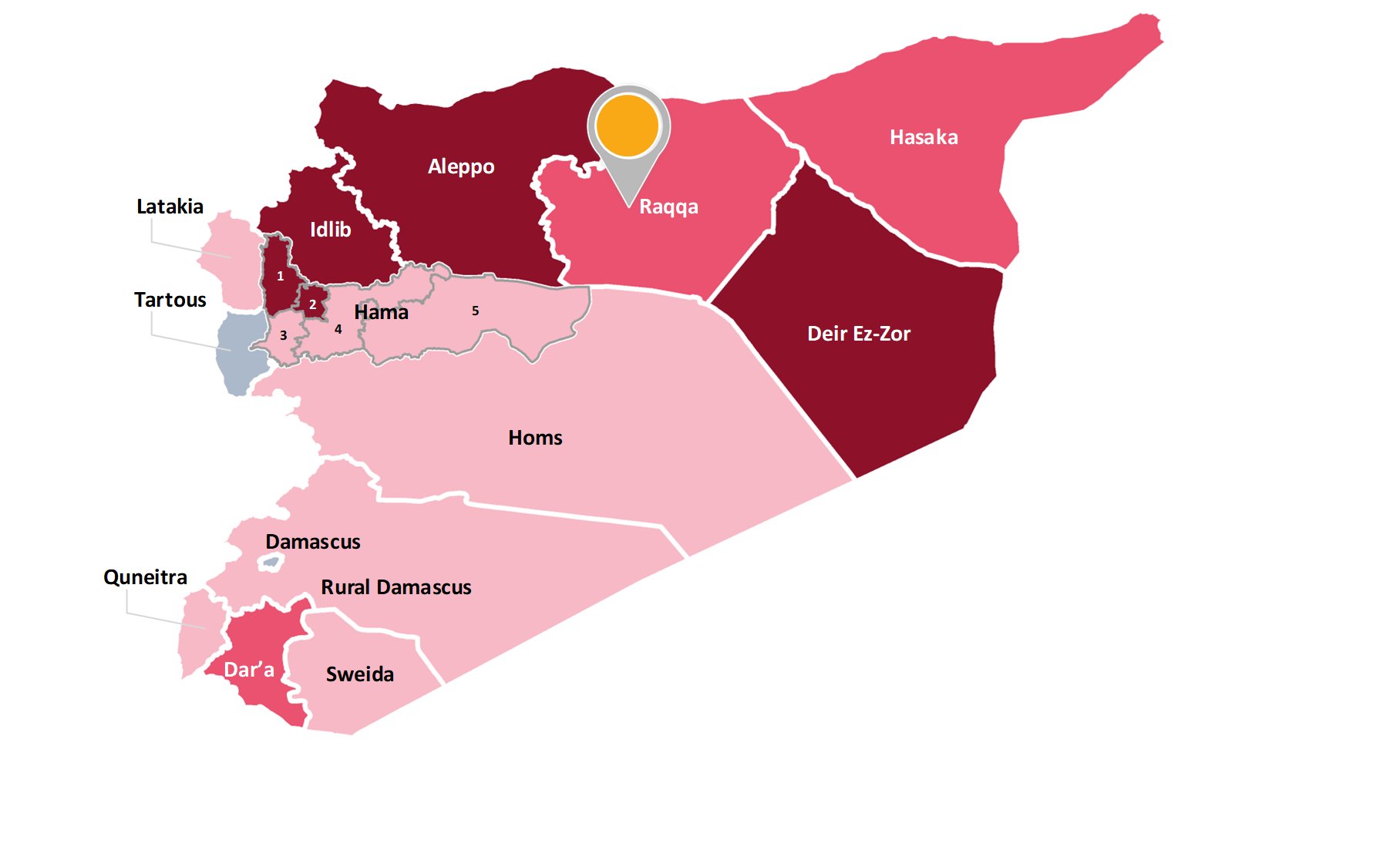[Main COI reference: Security 2020, 2.8]
The governorate of Raqqa is located in the north-central part of Syria, bordering Turkey to the north, Aleppo governorate to the west, Hasaka and Deir Ez-Zor governorates to the east, and Hama and Homs governorates to the south. The governorate is divided into three districts: Ar-Raqqa, Al-Thawra and Tall Abyad. The Syrian Central Bureau of Statistics estimated the population of Raqqa governorate at 853 000 as of 2016. Raqqa governorate, together with Deir Ez-Zor, is Syria’s main oil-producing region. Raqqa governorate is also Syria’s main area producing irrigated ‘strategic crops’ (wheat, barley, cotton and yellow corn).

Following the Turkish-led incursion into northeast Syria in October 2019, the SNA together with Turkish armed forces was reported to be in control of the so called ‘safe zone’ established between Tall Abyad (Raqqa governorate) and Ras al Ain (Hasaka governorate). After an agreement was reached between Turkey and Russia on 23 October 2019, the SDF withdrew on 28 October 2019 from this area, giving way to Turkish-supported non-State armed groups. In December 2019, Russian troops moved into Raqqa, following an agreement with the SDF, to guarantee safety after the departure of the US forces. Russia, in collaboration with the GoS, also deployed forces to the Tabqa Dam on the Euphrates River west of Raqqa city.
As of March 2020, in northeast Syria the SDF controlled most of Raqqa governorate, and the GoS forces controlled the areas south of Raqqa and along the Euphrates river.
During the first months of 2019, ISIL carried out ‘hit-and-run’ attacks and suicide attacks and bombings. Between April and June 2019, it was reported that ISIL conducted assassinations and attacks on local elites in Raqqa governorate ‘to prevent the establishment of capable security and governance structures’. From March through mid-October 2019, ISIL claimed to have conducted 98 insurgent attacks in Raqqa governorate [Security 2020, 1.4.6].
The security situation along the northern border of Raqqa governorate rapidly changed in October 2019 when US forces were withdrawn, and Turkey launched an offensive called ‘Operation Peace Spring’ into the Syrian border area. Since the start of the Turkish offensive, ground bombardments, summary killings and unlawful attacks have been reported, resulting in civilian casualties and displacement. On 14 October 2019, the SDF reached an agreement with the SAA to take control of long stretches of territory along the border with Turkey, in order to hold off a Turkish attack. Since the start of the Turkish offensive, Tall Abyad, which came under Turkish control, has been targeted by several heavy attacks, by car bombs and other explosive devices. By late November 2019, the so-called ‘safe zone’ between Tall Abyad and Ras al Ain had been secured by Turkey, and artillery shelling and air strikes had significantly decreased. Nevertheless, as the CoI reported, ‘the area experienced frequent attacks, including sporadic artillery shelling, ground skirmishes, car bombs and the use of other improvised explosive devices’. Indiscriminate use of IED attacks on residential areas and local markets in areas under the control of Turkish-backed groups has also been reported. Incidents related to landmines and explosives were also reported.
ACLED recorded 482 security incidents (average of 9 security incidents per week) in Raqqa governorate in 2019, the large majority of which coded as explosions/remote violence and battles. In the first two months of 2020, the number of security incidents in the governorate was 105, amounting to an average of 13 security incidents per week. The number of security incidents had remained steady for the first part of 2019, registering a significant spike in security incidents in October - November 2019.
Most security incidents were recorded in Tall Abyad district, followed by Raqqa district.
In 2019, VDC recorded a total of 166 civilian fatalities and SNHR recorded a total of 199 civilian fatalities in the governorate. Compared to the official figures for the population in the governorate as from 2016, this represents respectively 19 or 23 civilian fatalities per 100 000 inhabitants.
According to the UNOCHA, around 10 000 displacement movements were recorded during 2019 from Raqqa governorate, towards Hasaka, Aleppo and Deir Ez-Zor governorates. For the same period, around 58 000 IDP movements were recorded to or within Raqqa governorate, of which around 52 000 were within the governorate, while the rest came from Hasaka, Deir Ez-Zor, Rural Damascus and Aleppo governorates. Around 12 000 return movements were recorded to or within Raqqa governorate, of which 8 000 were within the governorate, while the rest returned mainly from Aleppo and Hasaka governorates.
Raqqa governorate has been severely damaged by the fighting against ISIL. It had led to a large-scale destruction of hospitals, schools, and other critical civilian infrastructure. The public health system in Raqqa has been severely damaged and a limited number of schools are operating. The public water network, the sewage system and public electricity grid of certain cities in Raqqa governorate are either completely destroyed in or have malfunctions. Road network in the governorate is also heavily damaged.
|
|
Looking at the indicators, it can be concluded that ‘mere presence’ in the area would not be sufficient to establish a real risk of serious harm under Article 15(c) QD in the governorate of Raqqa, however, indiscriminate violence reaches a high level, and, accordingly, a lower level of individual elements is required to show substantial grounds for believing that a civilian, returned to the territory, would face a real risk of serious harm within the meaning of Article 15(c) QD.
|
